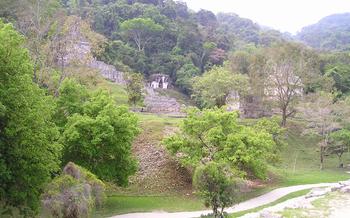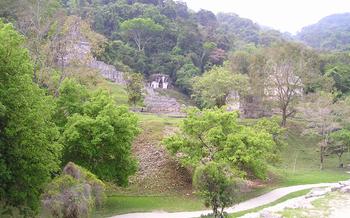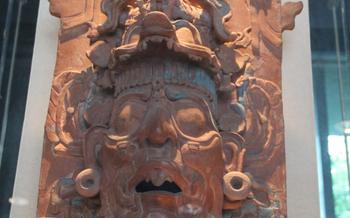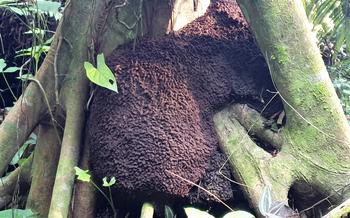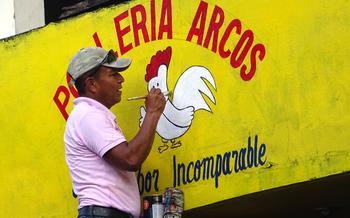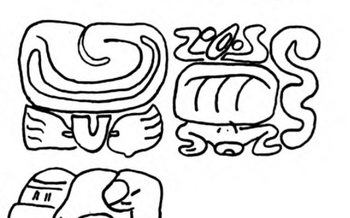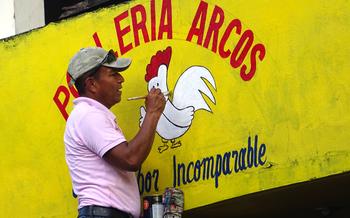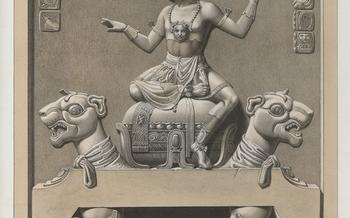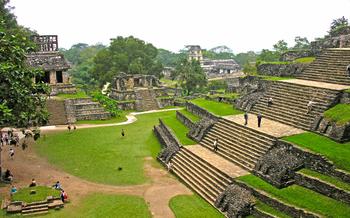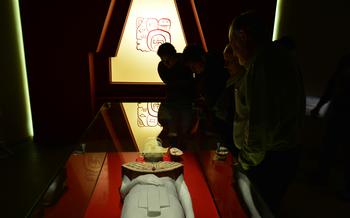
Temple of the Sun
- Historical Significance
- Location and Access
- Architectural Features
- Historical Events and Rituals
- Murals and Inscriptions
- Astronomy and Alignment
- Restoration and Conservation
- Excavations and Discoveries
- Other Notable Temples
- Surrounding Attractions
- Local Cuisine
- Accommodations
- Safety and Precautionary Measures
- Guided Tours
- Insider Tip: The Secret of the Jaguar Throne
Historical Significance
Palenque, once a thriving city-state of the ancient Maya civilization, is nestled amidst the verdant jungles of Chiapas, Mexico. Around the 7th century AD, during the Classic Maya period, Palenque reached the zenith of its power and cultural achievements. Among the city's architectural marvels stands the Temple of the Sun, an iconic symbol of Maya religious beliefs and artistry.
This majestic temple, dedicated to the sun god Kʼinich Janaabʼ Pakal, played a pivotal role in Maya cosmology. The Maya believed that the sun was a divine entity, responsible for sustaining life and ensuring the balance of the universe. The Temple of the Sun served as a sacred sanctuary where Maya rulers and priests performed elaborate rituals and ceremonies to honor the sun god and seek his blessings for prosperity and harmony in their kingdom.
Location and Access
The Temple of the Sun is situated in the heart of the ancient Maya city of Palenque, in the state of Chiapas, Mexico. It is part of the larger archaeological site known as the Palenque Ruins, which encompasses a complex of temples, palaces, and other structures.
To reach Palenque, you can take a domestic flight from Mexico City or Cancun to the nearby city of Villahermosa. From there, you can take a bus or arrange a private transfer to Palenque, approximately two hours away.
If you prefer to drive, Palenque is accessible by car via the federal highway 18The journey takes about 10 hours from Cancun and 6 hours from Villahermosa.
Once in Palenque, you can easily walk or take a short taxi ride to the entrance of the archaeological park. The Temple of the Sun is located within the park, and you can explore it independently or join a guided tour.
It's recommended to visit Palenque during the dry season (November to April) to avoid the heavy rains and humidity of the rainy season. The best time of day to visit the Temple of the Sun is early in the morning or late in the afternoon, when the temperatures are more pleasant.
Architectural Features
The Temple of the Sun stands as a testament to the advanced architectural prowess of the Maya civilization. Its imposing pyramidal structure rises from the surrounding jungle, its silhouette dominating the skyline. Constructed atop a rectangular platform, the temple features a series of steep, stepped levels that lead to a narrow summit. The exterior is adorned with intricate carvings and reliefs, showcasing the Maya's mastery of stonework.
A distinctive feature of the Temple of the Sun is its corbeled arch, a remarkable architectural element that allowed the Maya to create large, open spaces without the use of supporting columns. This innovative technique enabled them to construct grand interiors capable of accommodating religious ceremonies and rituals.
The temple's interior is divided into several chambers, each with its own unique purpose and significance. The main chamber, accessed through an imposing doorway, features a series of benches arranged around the walls. These benches likely served as seating for priests and other religious officials during ceremonies.
Another notable feature of the Temple of the Sun is its elaborate roof comb, a decorative element that extends from the top of the temple. The roof comb is adorned with intricate carvings and sculptures, depicting various deities and mythological scenes. It is believed that these roof combs served both a religious and a practical purpose, helping to channel rainwater away from the temple's interior.
The construction techniques employed in the Temple of the Sun demonstrate the Maya's ingenuity and precision. The temple was built using large limestone blocks, carefully cut and fitted together without the use of mortar. The blocks were quarried from a nearby source and transported to the temple site, where they were skillfully assembled to create the imposing structure that stands today.
Historical Events and Rituals
The Temple of the Sun served as a stage for significant historical events and religious ceremonies during the Maya civilization. One notable event associated with the temple is the accession of Pacal the Great to the throne in 615 AD. This event marked the beginning of a prosperous era for Palenque and solidified the temple's importance as a center of political and religious power.
Religious rituals and ceremonies were an integral part of Maya culture, and the Temple of the Sun was a sacred space where these rituals took place. The temple's interior walls are adorned with intricate carvings depicting various religious scenes and rituals. These carvings provide valuable insights into the beliefs and practices of the Maya people. One of the most important rituals performed within the temple was the K'inich Ahau, a ceremony dedicated to the sun god K'inich Ajaw. This ceremony involved elaborate offerings, prayers, and dances, and it played a crucial role in maintaining the balance between the earthly and spiritual realms.
Murals and Inscriptions
Inside the Temple of the Sun, visitors are treated to a spectacle of well-preserved murals that adorn the temple walls. These vibrant and intricate paintings provide a glimpse into the beliefs and rituals of the Maya civilization. The murals depict various scenes, including religious ceremonies, historical events, and mythological tales, offering a window into the cultural and spiritual life of the Maya people.
The iconography of the murals is rich in symbolism and allegory, with each element carefully chosen to convey a specific meaning. Scholars have dedicated years to interpreting these artistic expressions, unraveling the stories and messages they hold. The murals depict deities, rulers, and other important figures engaged in various activities, providing valuable insights into the social hierarchy and power structures of Maya society.
Another intriguing aspect of the Temple of the Sun is the presence of hieroglyphic inscriptions. These inscriptions, carved into the stone walls, serve as historical records and provide invaluable information about the temple's construction, its dedication, and the rulers who oversaw its creation. Epigraphers have worked tirelessly to decipher these inscriptions, shedding light on the political, economic, and religious aspects of Maya civilization.
Astronomy and Alignment
The Temple of the Sun showcases the Maya's advanced knowledge of astronomy and their deep connection to celestial events. The temple's alignment with the sun during the summer solstice is a testament to their understanding of the solar cycle. The precision of this alignment allowed the Maya to determine the exact date of the solstice and use it to regulate their agricultural practices.
The temple's orientation also coincides with the rising of the Pleiades star cluster, known as "Tzab" in Maya. The Pleiades held significant religious and agricultural importance for the Maya, as it marked the beginning of the rainy season and the planting of crops. By aligning the temple with the Pleiades, the Maya sought to ensure a successful harvest and maintain harmony with the natural world.
The Temple of the Sun's alignment with celestial events highlights the Maya's remarkable achievements in astronomy and their belief in the interconnectedness of the cosmos, their culture, and their daily lives. Understanding this alignment provides a deeper appreciation for the Maya civilization's intellectual prowess and their profound connection to the natural world.
Restoration and Conservation
Efforts to restore and preserve the Temple of the Sun have been ongoing for decades. In the 1950s, a team of archaeologists led by Alberto Ruz Lhuillier began a major excavation and restoration project at the site. This project involved clearing away vegetation, stabilizing the temple's structure, and reconstructing some of its collapsed walls and roofs. The archaeologists also conducted extensive studies of the temple's architecture, murals, and inscriptions, which helped to shed light on its history and significance.
In recent years, the Mexican government has allocated significant funding for the conservation of the Temple of the Sun and other Maya sites in Palenque. This funding has been used to improve the site's infrastructure, including the construction of new walkways and visitor centers. It has also been used to fund ongoing research and conservation projects, such as the digitization of the temple's murals and the development of new techniques for preserving the site's fragile stonework.
Despite the challenges, the Temple of the Sun remains one of the best-preserved Maya temples in Mesoamerica. Thanks to the efforts of archaeologists, conservators, and the Mexican government, this ancient marvel continues to inspire and awe visitors from around the world.
Excavations and Discoveries
Over the years, the Temple of the Sun has undergone extensive archaeological excavations, revealing hidden chambers and artifacts that have shed light on Maya history and culture. In the 1950s, Mexican archaeologist Alberto Ruz Lhuillier led a pivotal excavation that uncovered a secret chamber beneath the temple, known as the Crypt of the Red Queen. Inside, he found the remains of a high-ranking Maya woman, adorned with a wealth of jade jewelry and accompanied by various offerings. The discovery of the Red Queen's tomb provided valuable insights into the funerary practices and social status of Maya royalty.
In subsequent excavations, archaeologists unearthed a series of tunnels and chambers connected to the temple, revealing an intricate network of underground spaces. These discoveries suggested the presence of a complex system of rituals and ceremonies associated with the temple. Among the artifacts discovered were beautifully crafted ceramic vessels, obsidian blades, and intricate jade carvings, offering glimpses into the daily lives and religious practices of the ancient Maya.
Other Notable Temples
While the Temple of the Sun stands as Palenque's architectural crown jewel, the city boasts a treasure trove of other remarkable temples that offer unique insights into Maya culture and history.
-
The Temple of the Cross: This temple is renowned for its intricate carvings and bas-reliefs depicting scenes from Maya mythology and daily life. Its well-preserved condition makes it a must-see for history enthusiasts.
-
The Temple of the Foliated Cross: Another architectural marvel, this temple features elaborate stucco decorations and a unique cross-shaped design, symbolizing the Maya belief in the sacredness of the four cardinal directions.
-
The Temple of the Inscriptions: This temple is famous for housing the tomb of the great Maya ruler K'inich Janaab' Pakal, also known as Pacal the Great. The tomb's discovery in 1952 revealed a wealth of information about Maya burial practices and the life of one of the city's most prominent rulers.
Surrounding Attractions
Beyond the Temple of the Sun, Palenque offers a wealth of additional attractions to captivate visitors. The National Museum of Palenque houses an impressive collection of artifacts and exhibits showcasing the rich history and culture of the Maya civilization, including intricate sculptures, pottery, and jewelry.
For those seeking adventure, the Palenque National Park beckons with its lush rainforest trails, cascading waterfalls, and abundant wildlife. Hike through the jungle, encounter exotic birds and monkeys, and immerse yourself in the breathtaking natural beauty that surrounds this ancient city.
History buffs should not miss the Palenque Aqueduct, an engineering marvel that provided the city with a reliable water supply. Admire the well-preserved arches and channels that demonstrate the ingenuity of the Maya builders.
The Temple of the Cross is another must-see, known for its exquisite carvings and well-preserved stucco reliefs that depict scenes from Maya mythology and daily life. The nearby Temple of the Foliated Cross also boasts intricate carvings and offers stunning views of the surrounding jungle.
For a unique perspective, embark on a boat trip along the Usumacinta River, which meanders through the lush rainforest and offers glimpses of Maya ruins and wildlife along its banks. The riverbanks are home to a variety of birds, monkeys, and other animals, making it a perfect opportunity for nature enthusiasts.
Local Cuisine
When visiting Palenque, make sure to savor the delectable flavors of traditional Maya cuisine. This rich culinary heritage offers a unique blend of ancient recipes and modern influences. Indulge in the aromatic pibil, a slow-cooked pork dish wrapped in banana leaves and infused with achiote, a vibrant red spice. Try the panuchos, crispy tortillas filled with black beans and topped with turkey, lettuce, and tomato. For a refreshing treat, sip on pozol, a frothy maize-based drink, or quench your thirst with agua de chaya, a cooling beverage made from the chaya plant.
Savor the authentic flavors of Maya cuisine at local restaurants or visit the bustling markets to sample street food delights. Immerse yourself in the vibrant atmosphere as you interact with friendly vendors and learn about the history behind each dish. Whether you prefer spicy or mild flavors, vegetarian or meat-based options, the culinary scene in Palenque promises a delightful and memorable experience.
Accommodations
Palenque offers a range of accommodation options to suit different budgets and preferences. For a truly immersive experience, consider staying in one of the eco-lodges or haciendas located within or near the archaeological zone. These charming accommodations often feature traditional Maya architecture, lush gardens, and stunning views of the surrounding rainforest.
For those seeking more modern amenities, there are several hotels and guesthouses in the town of Palenque, just a short drive from the ruins. These offer a comfortable and convenient base for exploring the area, with easy access to restaurants, shops, and other attractions.
When choosing your accommodation, consider factors such as proximity to the ruins, desired amenities, and budget. It's advisable to book in advance, especially during peak season, to secure your preferred option.
Here are some additional tips for finding suitable lodging in Palenque:
- Budget travelers: Look for hostels, guesthouses, or budget hotels in the town of Palenque. These offer basic but comfortable accommodations at affordable rates.
- Mid-range travelers: Consider staying in one of the many mid-range hotels or lodges in the area. These typically offer private rooms, air conditioning, and other amenities.
- Luxury travelers: For a truly special experience, splurge on a stay at one of the luxury eco-lodges or haciendas. These offer top-notch amenities, personalized service, and unforgettable views.
No matter your budget or preferences, you're sure to find the perfect accommodation in Palenque to make your visit to this ancient Maya city a memorable one.
Safety and Precautionary Measures
Palenque is generally considered a safe destination for travelers; however, as with any tourist spot, it's crucial to exercise caution and take necessary precautions to ensure a hassle-free experience. Here are some safety tips to keep in mind:
-
Be aware of your surroundings: Remain vigilant and pay attention to your surroundings, especially in crowded areas. Keep an eye on your belongings to prevent theft.
-
Avoid walking alone at night: If possible, try to avoid walking alone, particularly in dimly lit areas or isolated streets.
-
Be cautious of touts and vendors: While many local vendors are friendly and honest, be wary of those who may be overly persistent or pushy. Politely decline unwanted offers or services.
-
Respect local customs and traditions: Familiarize yourself with local customs and traditions to avoid any misunderstandings or disrespectful behavior.
-
Protect yourself from the sun: Palenque's weather can be hot and humid, so remember to wear sunscreen, a hat, and sunglasses. Stay hydrated by drinking plenty of water.
-
Carry a flashlight: If you plan to explore the temple complex early in the morning or late in the evening, bring a flashlight or headlamp to navigate dimly lit areas.
-
Follow instructions and signage: Observe the instructions and signage provided at the site. Stay on designated paths and avoid climbing or touching fragile structures.
By following these simple precautions, you can ensure a safe and enjoyable visit to the Temple of the Sun and other attractions in Palenque.
Guided Tours
Exploring the Temple of the Sun with a knowledgeable guide can greatly enhance your understanding and appreciation of this ancient site. Guided tours offer several advantages:
-
In-depth knowledge: Experienced guides provide insightful commentary on the temple's history, architecture, murals, and significance in Maya culture. They can answer your questions and share interesting anecdotes that bring the site to life.
-
Customized experience: Group tours typically follow a set itinerary, but private tours can be tailored to your interests and pace. You can request specific topics or areas you want to focus on, and the guide will adjust the tour accordingly.
-
Hassle-free planning: Booking a guided tour takes the hassle out of planning your visit. The tour operator handles logistics such as transportation, entrance fees, and permits, allowing you to relax and focus on the experience.
When choosing a tour operator, look for reputable companies with experienced and certified guides. Read reviews from previous travelers to gauge the quality of their services. It's also a good idea to inquire about the group size to ensure a personalized experience.
Whether you opt for a group tour or a private guide, exploring the Temple of the Sun with a knowledgeable companion will undoubtedly enrich your visit and provide a deeper understanding of this awe-inspiring Maya legacy.
Insider Tip: The Secret of the Jaguar Throne
In the dimly lit interior of the Temple of the Sun, a hidden treasure awaits discovery. Beneath the watchful gaze of the ancient Maya gods, concealed within a secret chamber, lies the Jaguar Throne. This elaborately carved stone seat, adorned with intricate jaguar motifs, holds a captivating story that has remained shrouded in mystery for centuries.
As legend has it, the Jaguar Throne was once the sacred seat of power for the Maya rulers of Palenque. It is said that only the most revered and powerful leaders were granted the honor of sitting upon this throne, their authority and divine connection to the gods symbolized by this majestic feline.
While the exact purpose of the Jaguar Throne remains a subject of debate among scholars, its presence within the Temple of the Sun suggests its profound significance in Maya culture. Whether it served as a throne for earthly rulers or a symbolic representation of divine authority, the Jaguar Throne stands as a testament to the rich history and enduring legacy of the Maya civilization.
If you have the opportunity to explore the Temple of the Sun, be sure to seek out this hidden gem. The Jaguar Throne, with its enigmatic allure and captivating story, is a reminder of the enduring power and mystique of the Maya civilization.
